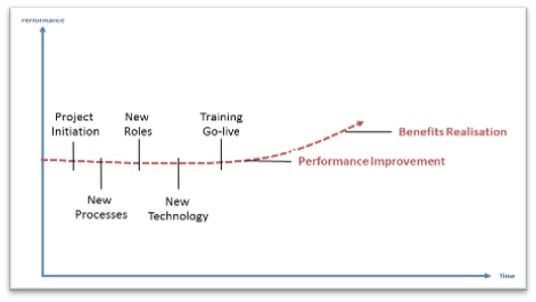Manage the Dip
Managing the Dip
Not all transformations completely fail, however, many organisations suffer from a drop in performance, or fail to realise the planned business benefits, especially in technology driven change.
In any large business transformation programme, the project team can expect to experience resistance or reluctance to change. Typically, management focus is on minimising the reluctance and the perceived inevitable “production dip”. However, the focus of the Business Change Team is to obtain a balance across people, process and technology activities in order to not only avoid the dip, but continuously improve Business’s customer experience and achieve increased business results.

Managing the dip in change management refers to the period of time when a change initiative encounters resistance, setbacks or even failure. This dip can be discouraging, but there are strategies that can help you manage it effectively. Here are some tips:
- Communicate effectively: During the dip, it's crucial to communicate with all stakeholders involved in the change initiative. Be transparent about the challenges you're facing and the progress that's being made. Listen to feedback and be open to making adjustments to the plan.
- Address resistance: Resistance to change is common, and it's important to address it head-on. Understand the reasons behind the resistance and provide support and resources to address concerns. Addressing resistance can help keep the change initiative on track.
The focus of the Change Team is to obtain a balance across people, process and technology activities in order to not only avoid the dip, but continuously improve customer experiences and achieve early business benefits.

4. Focus on small wins: Celebrating small wins can help boost morale and motivation during the dip. Identify areas where progress has been made and highlight them. This can help keep the team engaged and motivated to continue the change effort.
5. Stay flexible: During the dip, it's important to stay flexible and adjust the plan as needed. Be willing to make changes and try new approaches to address challenges and setbacks.
6.Seek support: Finally, don't be afraid to seek support from experts or colleagues who have experience managing change initiatives. They can provide guidance and support during challenging times.
Remember, managing the dip is a natural part of the change process. By being proactive and staying focused on the end goal, you can help ensure that the change initiative is successful in the long run.
Compose the Change
Browse by Categories

Free On-Line Change Management Methodology that enables individuals and organisations, especially those previously without access to effective change management programmes, to deliver more effective community and country programmes which improve prosperity and save lives.
QUICKLINKS
TRAINING LINKS
LATEST POSTS




